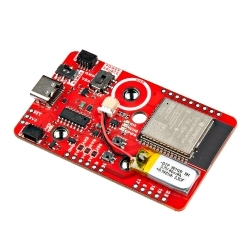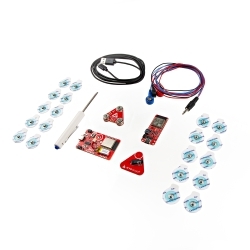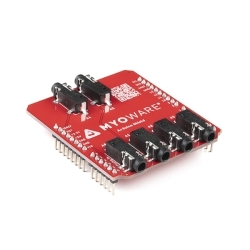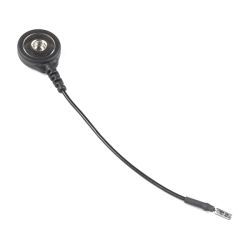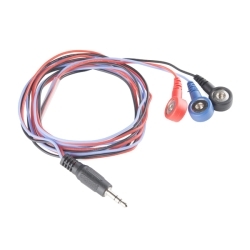MyoWare 2.0 Muscle Sensor
The MyoWare® 2.0 Muscle Sensor is an Arduino-powered, all-in-one electromyography (EMG) sensor from Advancer Technologies and SparkFun Electronics.
Helpful Documentation
Product Overview
Using our muscles to control things is the way that most of us are accustomed to doing it. We push buttons, pull levers, move joysticks... but what if we could take the buttons, levers and joysticks out of the equation and control it with our muscles? The MyoWare® 2.0 Muscle Sensor is an Arduino-compatible, all-in-one electromyography (EMG) sensor from Advancer Technologies that allows you to do just that! The MyoWare 2.0 Muscle Sensor has been redesigned from the ground up with a new easy-to-use, compact design and upgraded with the latest and greatest chipset improving sensor performance and reliability. The innovative snap connector system eliminates the need to solder connections for the MyoWare 2.0 ecosystem. It's that easy: stick on a few electrodes (not included), read the output voltage and flex some muscles!
The MyoWare 2.0 Muscle Sensor measures muscle activity through the electric potential of the muscle, commonly referred to as surface electromyography (EMG or sEMG for short). When your brain tells your muscle to flex, it sends an electrical signal to your muscle to start recruiting motor units (the bundles of muscle fibers that generate the force behind your muscles).
The harder you flex, the more motor units are recruited to generate great muscle force. The greater the number of motor units, the more the electrical activity of your muscle increases. MyoWare 2.0 Muscle Sensor will analyze the filtered and rectified electrical activity of a muscle and output a signal (0-VIN volts, where VIN signifies the voltage of the power source) that represents how hard the muscle is being flexed.
The MyoWare 2.0 Muscle Sensor builds upon its previous wearable design that allows you to attach biomedical sensor pads directly to the board itself, getting rid of those pesky cables. This board includes a single-supply voltage of +3.3V to +5V, three output modes, reverse polarity protected power pins, and indicator LEDs. Additionally, we have developed a few shields (such as the Cable, Power, and LED shields to name a few) that can attach to the MyoWare 2.0 Muscle Sensor to help increase its versatility and functionality! The muscle sensor’s snap connector system makes it easier to stack shields together. The top side connectors link to power and the sensor’s EMG envelope output while the bottom side links to the input electrodes.
Measuring muscle activity by detecting its electric potential has traditionally been used for medical research. However, with the advent of ever shrinking yet more powerful microcontrollers and integrated circuits, EMG circuits and sensors have found their way into all kinds of control systems such as video games, robotics, and prosthetics! Biomedical sensor pads can be found in the Recommended Products section below to be purchased separately.
Note: MyoWare and the Muscle Sensor are not intended for use in the diagnosis of disease or other conditions, or in the cure, mitigation treatment, or prevention of disease, in a man or other animals.
The MyoWare® 2.0 ecosystem consists of shields that easily interface with the MyoWare® 2.0 Muscle Sensor, which is a low-cost, Arduino-compatible, all-in-one electromyography (EMG) sensor from Advancer Technologies. The innovative connector system allows users to easily snap shields together with a compact low profile and connect to a microcontroller's analog input to measure raw, filtered, and rectified electrical activity of a target muscle. This eliminates the need to solder connections between boards.
This product is a collaboration with Brian Kaminski from Advancer Technologies. A portion of each sales goes back to them for product support and continued development.
Features & Specs
- Wearable Design
- Supply Voltage
- Minimum: +2.27V
- Typically: +3.3V to +5V
- Maximum: +5.47V
- Input Bias Current
- 250pA, max 1nA
- Reverse Polarity Protection
- Three Output Modes
- Raw EMG
- Rectified
- Envelope
- Expandable via Shields
- MyoWare® 2.0 Muscle Sensor Form Factor
- 3x Female Snap Pins (Input Electrodes)
- 3x Male Snap Pins (Power and EMG Envelope Output)
- LED Indicators
- VIN
- ENV
- Reference Electrode Jumper
- Specially Designed For Microcontrollers
- Adjustable Gain
- Board Dimensions
- 37.57mm x 35.90mm (1.48” x 1.41”)
- PCB board thickness increased.
- NPTH for snap connector buttons.
- Updated footprint for snap connectors buttons with slots for improved cleaning.
- Updated size of reference pin's jumper pad.
Documentation
- Board Dimensions
- Hookup Guide
- Advancer Technologies: MyoWare® 2.0
- Quickstart Guide (4.37MB)
- Advanced Guide (9.00MB)
- Patents [1]
- Arduino Reference Language: ArduinoBLE Library
- GitHub Example Repo
- MyoWare 2.0 Ecosystem Page
[1] Note: This product is patent protected. To prevent counterfeit boards
Customer Reviews
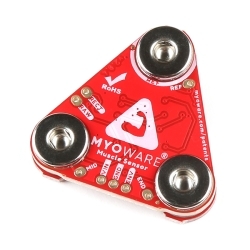
Stock and Customer Discounts
Available Discounts
- $41.33 | 10+ units
- $39.15 | 25+ units
- $36.98 | 100+ units


 Hookup Guide
Hookup Guide

